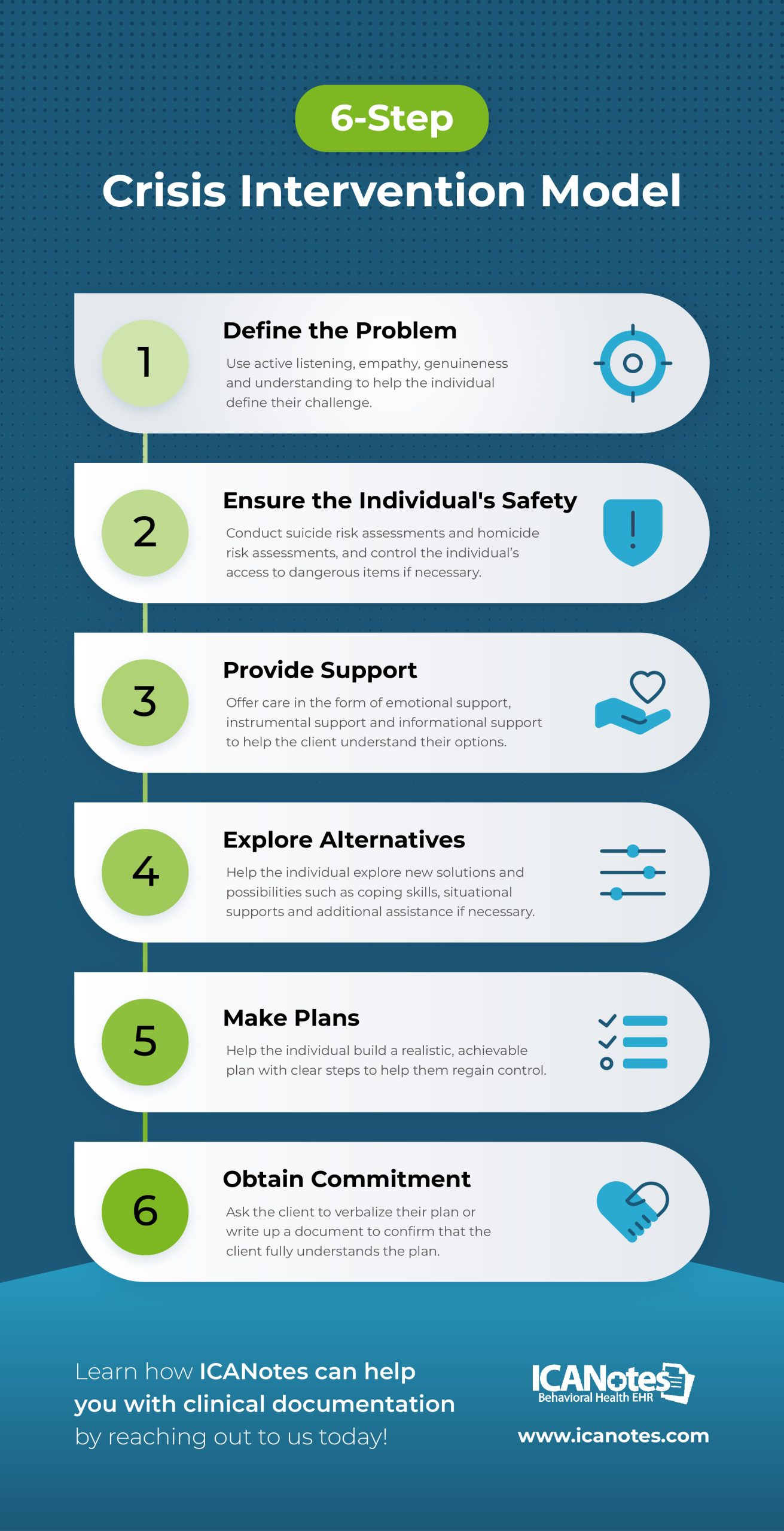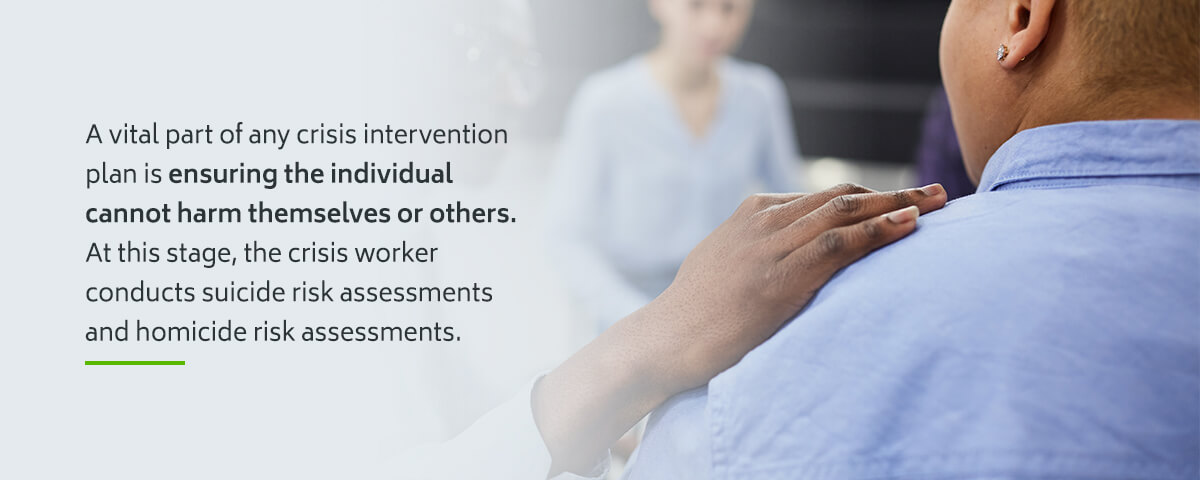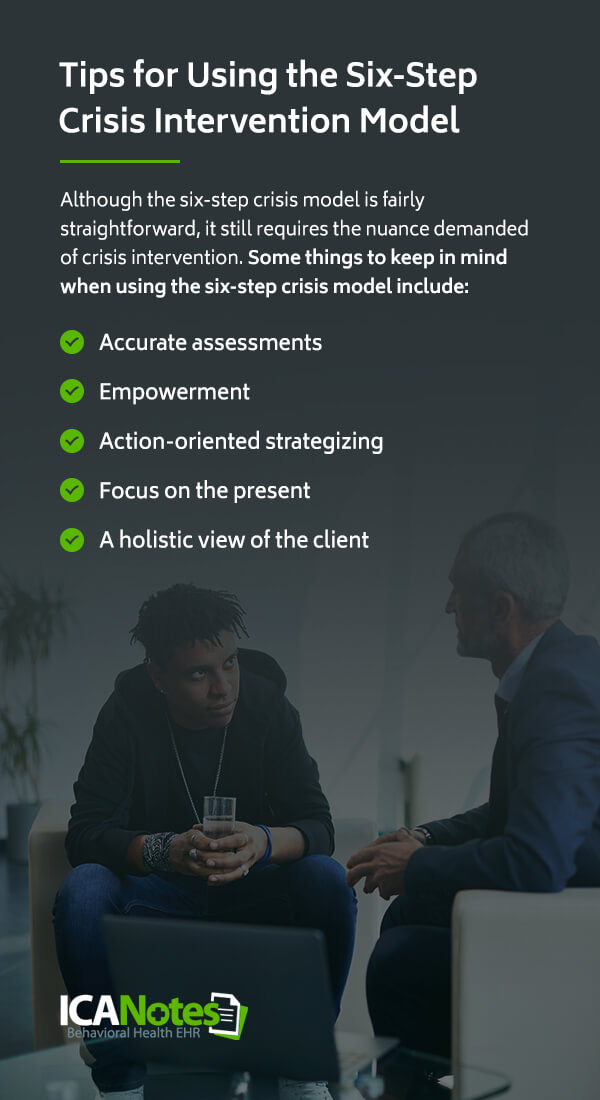Blog > Treatment Strategies > The Six-Step Crisis Intervention Model Explained
Clinicians should take note of this blog post because it demystifies the widely-used Six‑Step Crisis Intervention Model—offering a clear, structured framework to support clients in acute distress. By reading, you'll learn how to define a crisis clearly, ensure safety, offer support, explore options, develop a realistic plan, and secure client commitment—a practical guide to enhancing crisis responsiveness and therapeutic outcomes.

Last Updated: June 11, 2025

When an individual experiences a crisis, the proper response can make a life-saving difference. Mental health professionals must understand these nuanced situations and enact steps to bring the patient back to a healthy place. One model that can guide these responses is Gilliland's six-step crisis intervention strategy. By moving through the steps with care and concern for the individual, mental health professionals can help guide the person in crisis away from dangerous actions and toward their pre-crisis state.
We'll take a closer look at this crisis intervention model and how crisis workers can use it to assist their clients.
What is the Six-Step Crisis Intervention Model?
According to the creators of the six-step model, a crisis occurs when someone perceives or experiences an event or situation as intolerable, with demands that exceed their current resources and coping mechanisms. When this happens, they need assistance to regain control and stabilize. The six-step model enlists a systematic process of listening and responding to empower the individual and help them return to their pre-crisis psychological state. Assessments occur at every step, and the crisis worker listens attentively to make their evaluations.
The six steps involved in this method include three listening-oriented steps and three action-oriented steps. The first three focus on listening.
Step 1: Define the Problem
Step number one asks the crisis worker to define the problem. This first stage establishes a connection between the crisis worker and the client as they begin discussing the issue. To fully understand the situation and form a bond with the client, the crisis worker implements:
- Active listening: Active listening requires placing your full attention on the client, demonstrating acceptance and removing biases. The crisis worker must understand the client's perspective without allowing their feelings to get in the way. This type of listening also helps improve the relationship between the two parties.
- Empathy: Practicing empathy is about taking someone else's point of view and showing them that you understand them. It asks you to remove any judgment or biases and accept the patient as a whole person, not define them by their current situation. It also requires being in the present and putting the other person and their feelings first. Empathy is essential throughout the six-step process, especially when establishing the relationship.
- Genuineness: People can often tell when you aren't being genuine. In a crisis, this can quickly paint you as untrustworthy and break down the relationship between crisis worker and client. Speak genuinely but carefully and solidify your position as a trustworthy partner in their mental health.

- Understanding: You also need to show the client that you understand their situation. You may use language that confirms you understand the problem or relate to their issue somehow.
The crisis worker should look at the problem from the client's point of view. They should try to understand where the client is coming from and their available resources, such as coping skills or caring friends and family.
Step 2: Ensure the Individual's Safety
A vital part of any crisis intervention plan is ensuring the individual cannot harm themselves or others. At this stage, the crisis worker conducts suicide risk assessments and homicide risk assessments. You may evaluate factors like agitation or the client's potential for causing harm.
Another important step here is controlling the individual's access to dangerous items. These can be as clear-cut as firearms or as subtle as office supplies, like staplers and paper cutters. The client's location and the resources of the mental health crisis system will make a big difference in this step.
For example, an inpatient psychiatric client likely has far less access to harmful items than a client being treated through a mobile care unit. That client might be able to use a variety of dangerous instruments and lack supervision when the crisis worker leaves.
The crisis worker must help transition the client into a safe environment before they can work on the next steps.

Step 3: Provide Support
In the third step, the crisis worker shows the client that they accept and care for them. They'll discuss the problem and offer support for meeting basic needs. These might come in the form of:
- Emotional support: The crisis worker must express emotional support through statements that illustrate empathy, trust, and care. Emotional support can also come from trusted friends and family.
- Instrumental support: Instrumental support refers to services and aid, like shelter and food. Fulfilling basic needs is a necessary prerequisite for the problem-solving that occurs in the next three action steps.
- Informational support: By providing informational support, the crisis worker offers advice and suggestions. You might teach the individual about healthy coping strategies or reassure them that many resources are available.
The goal of these supports is to set the person up so they can understand the options available for dealing with the situation.
Be ready when your clients need you most!
Download our Crisis Intervention Toolkit for Mental Health Clinicians—equip yourself with the essential tools to confidently navigate crisis situations in your practice. This toolkit is packed with evidence-based de-escalation techniques, guided questions for assessing suicide risk, and printable safety plans and coping tool worksheets.
Step 4: Explore Alternatives
As we switch gears into the action steps, step four is about finding new solutions and navigating possibilities. The crisis worker collaborates with the person in crisis to explore these options. If their coping skills are weaker, the crisis worker may need to offer more assistance at this step, but it's important to draw on assessments first to understand the client's capabilities.
Other elements that the crisis workers might draw on during this step include situational supports, like people in the individual's life who care about them or coping mechanisms that can help them through the situation so they can move into the problem-solving stage.
During this step, it's necessary to use and cultivate positive, constructive thinking patterns. The crisis worker may need to spend some time helping the client reframe their thoughts in more positive ways.

Step 5: Make Plans
With trust established and options explored, it's time to make a plan. During step five, the individual and the crisis worker continue to collaborate, building a plan with clear, concrete steps that will help the client regain control. These plans must be realistic and achievable.
They should empower the client, making them feel like they can accomplish the tasks and take ownership of the recovery process. This step relies heavily on collaboration with the client because it helps them take control, using their existing resources and capabilities.
The individual's plan should be detailed and straightforward. It might involve referrals and resources like people or groups that can help the client, such as support groups, medical providers, or food banks.
Step 6: Obtain Commitment
The last step is to obtain commitment. Getting commitment might be as simple as asking the client to verbalize the plan or as complex as writing up a document and having both parties sign it. In either case, the crisis worker needs to confirm that the client fully understands the plan and feels capable of following through.
The crisis worker should also make plans to follow up with the client. You can create a sense of accountability and, of course, help ensure the client's well-being. If the client needs further care, the crisis worker can also make referrals.
The Benefits of the Six-Step Crisis Intervention Model
Crisis intervention is a powerful tool. An unmanaged crisis can lead to significant psychological stress, which can link to major depressive disorder or other mental health conditions. Crisis intervention has proven efficacy in preventing mental illness from developing and helping to treat patients currently suffering from one.
Studies have even shown that emergency departments with crisis intervention teams saw reduced return visits and shorter durations of stay. They reduced the number of repeat admissions and found that the interventions were more effective than standard care in improving the patient's mental health.
We know that crisis intervention can be a critical part of improving psychiatric case outcomes. The six-step model emphasizes two distinct components of helping someone with a problem — listening and taking action. It covers vital steps of crisis intervention, like creating a bond with the client, identifying resources, and guiding them toward a healthy solution. It also offers a clear, systematic approach that helps ensure the crisis worker accomplishes the tasks that can help the client.
Tips for Using the Six-Step Crisis Intervention Model
Although the six-step crisis model is fairly straightforward, it still requires the nuance demanded of crisis intervention. Some things to keep in mind when using the six-step crisis model include:
- Accurate assessments: This strategy is based on the results of your assessments. They must be accurate. Crisis workers must remember that every person and situation is unique. Generalizations can lead to dangerous errors that divert the treatment plan. Robust assessment tools can be particularly useful in the six-step strategy.
- Empowerment: Crises occur when a person loses control and feels unsafe. The six-step model focuses on restoring that power through collaboration. The crisis worker should maintain an open mind when problem-solving and look for routes that help the person regain control. A heavy-handed approach might be necessary for some patients, but they should contribute to the best of their ability.
- Action-oriented strategizing: Crisis intervention is focused on action and the situation at hand. Crisis workers should recognize the impacts of the situation, anticipate its effects and help the client create a plan. Each step in the process should be geared toward that end goal.
- Focus on the present: Similarly, crisis intervention offers immediate support. Unlike long-term solutions like psychotherapy, the crisis worker must provide immediate support, like coping skills that the patient can use right away or access to resources that they can use to quickly return to the pre-crisis state.
- A holistic view of the client: The crisis worker needs to maintain their holistic view of the client, considering the whole person instead of separating them from their cognitive and emotional function.

When to Use the Six-Step Crisis Intervention Model
Crisis intervention is an immediate, short-term response to mental, physical, emotional and behavioral distress. It is not a long-term option like psychotherapy or similar treatments. The goal is to restore the person's functioning to before the crisis and reduce the opportunity for long-term trauma. It aims to help the client get access to assistance, support and resources that help them become stable.
The six-step model can be used in many situations, but some common triggers for crises include:
- Family situations: Some family situations — like child or spousal abuse, unplanned pregnancy or serious or chronic illness — can cause stress and lead to a crisis.
- Economic situations: Financial strain from the loss of a job, eviction, theft, medical expenses, gambling or poverty can trigger many crises based on the sudden or chronic financial strain they create.
- Community situations: An individual's community can also contribute to their mental state. For example, someone facing violence in their neighborhood, poor housing or inadequate community resources might experience a crisis.
- Significant life events: Some events often viewed as happy situations can paradoxically trigger crises. These might include marriage, the birth of a child or a promotion at work. Other significant events, like raising a rebellious adolescent, losing a loved one or seeing a grown child leave the nest can also cause a crisis.
- Natural elements: Plenty of natural disasters can trigger crises, such as floods, hurricanes and fires. They might involve harm to a loved one or the destruction of possessions, creating states of distress. Even seemingly minor events, like a bout of gloomy or hot weather, can put someone into a crisis state.
Some signs that someone is in crisis and may need the help of an intervention strategy include:
- Feelings of hopelessness.
- Anger.
- Difficulty eating or sleeping.
- Depression.
- Denial.
- Neglected personal hygiene.
- Isolation.
- Apathy.
- Anxiety.
Symptoms can vary widely, but remember that a crisis intervention plan is generally warranted when the situation exceeds the patient's resources and coping skills.

Implementing the Six-Step Crisis Intervention Model
Implementing the six-step crisis intervention model will look different for various providers, such as inpatient crisis teams or mobile crisis response units. Still, completing the six steps typically requires robust documentation to ensure appropriate billing procedures, patient assessment, and follow-up care. Without the proper documentation solution, you might be spending too much time on paperwork and not enough time on the client. Or you might completely neglect your notes. To make the process easier, use a documentation platform that allows for quick, intuitive note-taking.
ICANotes is that platform, offering a cloud-based solution for mobile, inpatient, or outpatient crisis intervention. It eliminates the busy work, allowing you to focus on your patient and their acute problems without ignoring necessary documentation procedures. ICANotes mental health EHR software also supports a range of other tasks, like billing, reporting, referrals, e-prescribing and scheduling. From initial suicide risk assessments to referrals to other mental health professionals, ICANotes simplifies the entire process.
If the six-step crisis intervention model is part of your practice, ICANotes can help. With intuitive note-taking features and an array of assessment tools, you can successfully follow the patient-centered approach of this model. Collect all the information you need to make an accurate evaluation and help the patient move forward. To learn more about ICANotes and how it can help you with the 6-step model, explore its features or call us at 443-347-0990 for more information!
Start Your 30-Day Free Trial
Experience the most intuitive, clinically robust EHR designed for behavioral health professionals, built to streamline documentation, improve compliance, and enhance patient care.
Simplify clinical charting
Stay organized with appointment scheduling
Reduce no-shows with automated reminders
Improve client engagement with a secure patient portal
Provide flexible care with HIPAA-compliant telehealth
Dr. October Boyles is a behavioral health expert and clinical leader with extensive expertise in nursing, compliance, and healthcare operations. With a Doctor of Nursing Practice (DNP) from Aspen University and advanced degrees in nursing, she specializes in evidence-based practices, EHR optimization, and improving outcomes in behavioral health settings. Dr. Boyles is passionate about empowering clinicians with the tools and strategies needed to deliver high-quality, patient-centered care.









